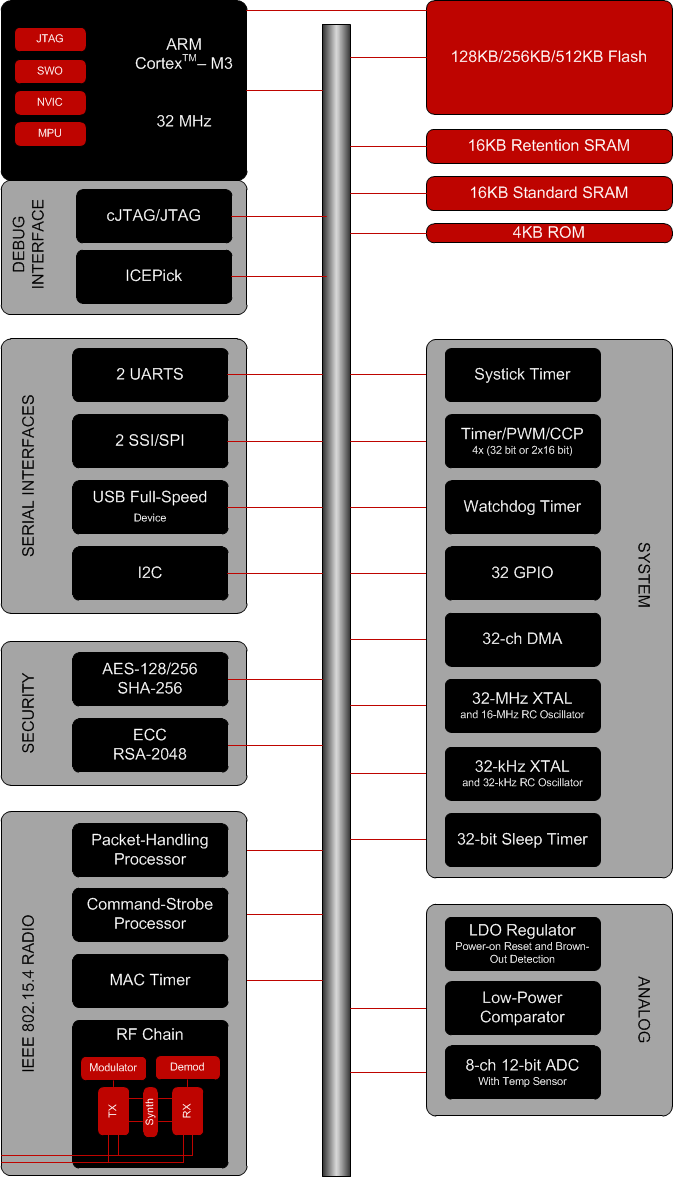SWRS096D December 2012 – April 2015 CC2538
PRODUCTION DATA.
- 1Device Overview
- 2Revision History
- 3Device Comparison
- 4Terminal Configuration and Functions
-
5Specifications
- 5.1 Absolute Maximum Ratings
- 5.2 ESD Ratings
- 5.3 Recommended Operating Conditions
- 5.4 Electrical Characteristics
- 5.5 General Characteristics
- 5.6 RF Receive Section
- 5.7 RF Transmit Section
- 5.8 32-MHz Crystal Oscillator
- 5.9 32.768-kHz Crystal Oscillator
- 5.10 32-kHz RC Oscillator
- 5.11 16-MHz RC Oscillator
- 5.12 RSSI/CCA Characteristics
- 5.13 FREQEST Characteristics
- 5.14 Frequency Synthesizer Characteristics
- 5.15 Analog Temperature Sensor
- 5.16 ADC Characteristics
- 5.17 Control Input AC Characteristics
- 5.18 DC Characteristics
- 5.19 USB Interface DC Characteristics
- 5.20 Thermal Resistance Characteristics for RTQ Package
- 6Applications, Implementation, and Layout
- 7Device and Documentation Support
- 8Mechanical Packaging and Orderable Information
Package Options
Mechanical Data (Package|Pins)
- RTQ|56
Thermal pad, mechanical data (Package|Pins)
- RTQ|56
Orderable Information
1 Device Overview
1.1 Features
-
Microcontroller
- Powerful ARM® Cortex®-M3 With Code Prefetch
- Up to 32-MHz Clock Speed
- 512KB, 256KB or 128KB of In-System-Programmable Flash
- Supports On-Chip Over-the-Air Upgrade (OTA)
- Supports Dual ZigBee Application Profiles
- Up to 32KB of RAM (16KB With Retention in All Power Modes)
- cJTAG and JTAG Debugging
- RF
- 2.4-GHz IEEE 802.15.4 Compliant RF Transceiver
- Excellent Receiver Sensitivity of –97 dBm
- Robustness to Interference With ACR of 44 dB
- Programmable Output Power up to 7 dBm
- Security Hardware Acceleration
- Future Proof AES-128/256, SHA2 Hardware Encryption Engine
- Optional – ECC-128/256, RSA Hardware Acceleration Engine for Secure Key Exchange
- Radio Command Strobe Processor and Packet Handling Processor for Low-Level MAC Functionality
- Low Power
- Active-Mode RX (CPU Idle): 20 mA
- Active-Mode TX at 0 dBm (CPU Idle): 24 mA
- Power Mode 1 (4-µs Wake-Up, 32-KB RAM Retention, Full Register Retention): 0.6 mA
- Power Mode 2 (Sleep Timer Running, 16-KB RAM Retention, Configuration Register Retention): 1.3 µA
- Power Mode 3 (External Interrupts, 16-KB RAM Retention, Configuration Register Retention): 0.4 µA
- Wide Supply-Voltage Range (2 V to 3.6 V)
- Peripherals
- µDMA
- 4 × General-Purpose Timers
(Each 32-Bit or 2 × 16-Bit) - 32-Bit 32-kHz Sleep Timer
- 12-Bit ADC With 8 Channels and Configurable Resolution
- Battery Monitor and Temperature Sensor
- USB 2.0 Full-Speed Device (12 Mbps)
- 2 × SPI
- 2 × UART
- I2C
- 32 General-Purpose I/O Pins
(28 × 4 mA, 4 × 20 mA) - Watchdog Timer
- Layout
- 8-mm × 8-mm QFN56 Package
- Robust Device for Industrial Operation up to
125°C - Few External Components
- Only a Single Crystal Needed for Asynchronous Networks
- Development Tools
- CC2538 Development Kit
- Reference Design Certified Under FCC and ETSI Regulations
- Full Software Support for Contiki/6LoWPAN, Smart Grid, Lighting, and ZigBee Home Automation With Sample Applications and Reference Designs Available
- Code Composer Studio™
- IAR Embedded Workbench® for ARM
- SmartRF™ Studio
- SmartRF Flash Programmer
1.2 Applications
- Smart Grid and Home Area Network
- Home and Building Automation
- Intelligent Lighting Systems
- Wireless Sensor Networks
- Internet of Things
1.3 Description
The CC2538xFnn is the ideal wireless microcontroller System-on-Chip (SoC) for high-performance ZigBee applications. The device combines a powerful ARM Cortex-M3-based MCU system with up to 32KB on-chip RAM and up to 512KB on-chip flash with a robust IEEE 802.15.4 radio. This enables the device to handle complex network stacks with security, demanding applications, and over-the-air download. Thirty-two GPIOs and serial peripherals enable simple connections to the rest of the board. The powerful hardware security accelerators enable quick and efficient authentication and encryption while leaving the CPU free to handle application tasks. The multiple low-power modes with retention enable quick startup from sleep and minimum energy spent to perform periodic tasks. For a smooth development, the CC2538xFnn includes a powerful debugging system and a comprehensive driver library. To reduce the application flash footprint, CC2538xFnn ROM includes a utility function library and a serial boot loader. Combined with the robust and comprehensive Z-Stack software solutions from TI, the CC2538 provides the most capable and proven ZigBee solution in the market.
